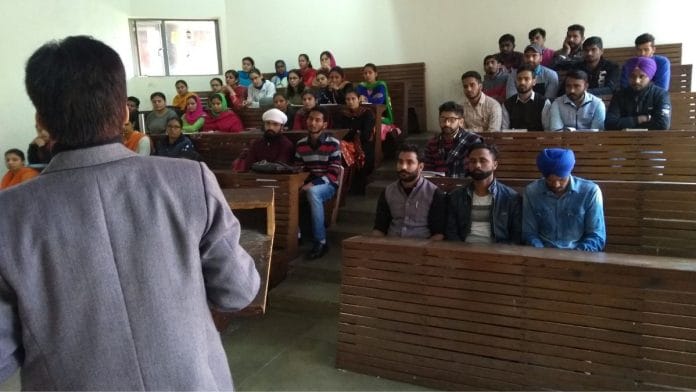Thank you dear subscribers, we are overwhelmed with your response.
Your Turn is a unique section from ThePrint featuring points of view from its subscribers. If you are a subscriber, have a point of view, please send it to us. If not, do subscribe here: https://theprint.in/subscribe/
India’s education sector bears the weight of generations past, a complex patchwork of progress and persistent inequities. While strides have been made in increasing overall enrolment in higher education, a glaring anomaly remains: the underrepresentation of women. This is not merely a statistical blemish; it is a societal handicap, a missed opportunity to harness the full potential of half the population. To truly unlock India’s potential and march towards a future of shared prosperity, public policy must undergo a radical rethink when it comes to gender equality in higher education. The reasons for this underrepresentation are multi-faceted, deeply embedded in social fabric and economic constraints. Patriarchal attitudes prioritizing boys’ education, societal pressures on girls to marry young, and limited access to safe and quality girls’ hostels in rural areas are just some of the hurdles. Add to this the lack of gender-sensitive infrastructure on campuses, inadequate sanitary facilities, and a dearth of female faculty members to serve as role models, and the picture becomes even starker.
Public policy cannot afford to be a silent bystander in this struggle. The time for piecemeal initiatives and lukewarm pronouncements is over. We need a comprehensive, multi-pronged approach that tackles the issue at its roots. Firstly, prioritize access. Invest in opening and upgrading girls’ schools, particularly in rural areas, and ensure they are adequately staffed and equipped. Provide scholarships and stipends specifically for girls from underprivileged backgrounds, making higher education a viable path regardless of economic constraints. Secondly, dismantle the invisible barriers. Address campus safety concerns by increasing security measures, implementing robust grievance redressal mechanisms, and sensitizing male students and faculty. Create gender-inclusive spaces and infrastructure, from accessible hygiene facilities to dedicated women’s study areas. Thirdly, empower and inspire. Increase the number of female faculty members across various disciplines, providing role models and creating a network of mentorship and support for younger women. Encourage research in gender studies and incorporate it into mainstream curricula, challenging stereotypical assumptions and fostering gender awareness. Furthermore, engage communities. Collaborate with local panchayats and NGOs to address societal misconceptions and promote girls’ education. Educate mothers and families about the long-term benefits of investing in daughters. Encourage boys to become allies, challenging patriarchal norms and advocating for equal opportunities. Finally, hold institutions accountable. Set clear targets for increasing female enrollment and faculty representation, with measurable outcomes and transparent reporting mechanisms. Regularly audit campuses for ensuring gender-sensitive policies are implemented effectively.
The dividends of achieving gender equality in higher education are immense. Imagine a future where classrooms buzz with diverse voices, where leadership positions are filled not by gender, but by merit, where innovation thrives fueled by the combined intellect of both men and women. This is not merely an ideal; it is a strategic necessity for a nation aspiring to be a global leader. Therefore, let us not be fooled by empty statistics or incremental progress. Let us demand a public policy that truly liberates, that shatters glass ceilings and builds bridges across the gender divide. Only then can we truly claim to be building an India where every mind gets the chance to soar, regardless of its gender. This is not just about equity; it’s about unleashing the full potential of a nation.
(Dr. Deevanshu Shrivastava, Associate Dean, School of Law, G D Goenka University, Gurugram)
These pieces are being published as they have been received – they have not been edited/fact-checked by ThePrint


